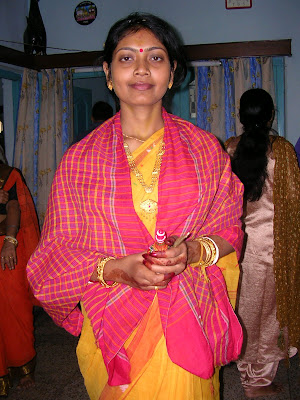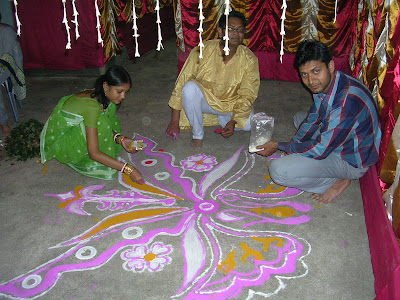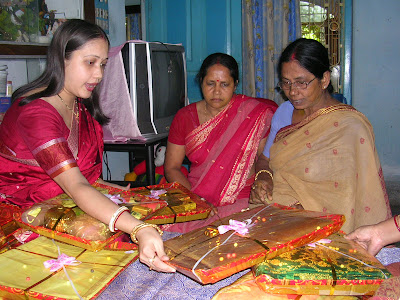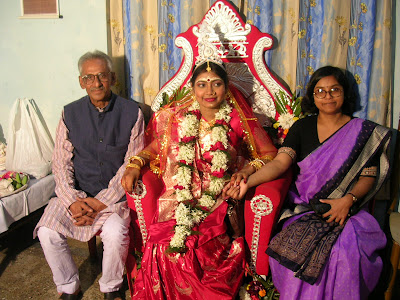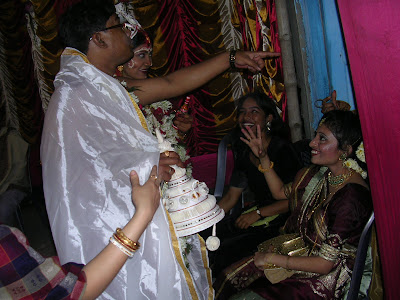Bengali Wedding
Besides being full of bright, beautiful colors, Bengali Hindu weddings are something of a feat of endurance occurring in ceremonial fits and ritualistic spurts over the course of three days.
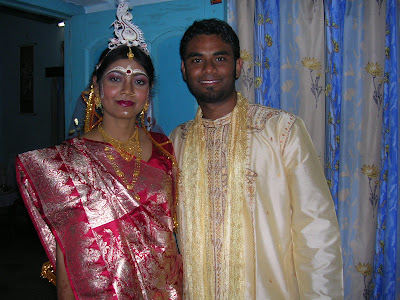
Delayed to a degree by my bout with pollution induced cold and flu (Calcutta) followed in quick succession by a bout of dysentery (Varanasi) followed next by a third round with severe viral fever (Delhi) I, undaunted if a bit weakened, once again pick up my (proverbial electrical) pen…
Among my numerous noteworthy experiences in India so far, there have been two that have been truly extraordinary. The first was watching the military border closing ceremony on the India-Pakistan border, and second: watching a Bengali Hindu wedding last week. I’ll leave the first for next time, and focus on the second today.
Besides being full of bright, beautiful colors, Bengali Hindu weddings are something of a feat of endurance occurring in ceremonial fits and ritualistic spurts over the course of three days. I say Bengali Hindu weddings because I don’t know how weddings differ for non-Bengalis or non-Hindus. Much is the same I’m told but I’m not clear on the differences.
The first day is when the wedding occurs and is registered. The second day the groom takes the bride from her home to his and the rest of the time is spent resting from the previous days activities. Finally, the third day is when the groom throws a reception party (called the boubhat) celebrating the arrival of the bride to his family.
Morning of the Wedding
The ‘when’ of the wedding, the day of the wedding as well as the time are determined beforehand from a holy book called Panji. Since many people use this same holy book, it is not at all uncommon for certain days (inconvenient non weekend days!) in a certain month to have hundreds of weddings followed by long periods of unholy, but otherwise wonderful days of no weddings at all. (Imagine the difficulty of finding available venues!) The time of the wedding (the logno) is also not accommodating in any real way and can be three in the morning or around noon. The wedding I attended happened to be on a Monday, and the logno was at an unfortunate (but I repeat holy) 11:48pm.
As venues are always a scare commodity and generally expensive, most weddings are held in these temporary structures called wedding pandels which are constructed of bamboo and multicolored cloth adjacent to the bride’s home. There is a section for the marriage ceremonies and a separate section for the food. All around the pandel there is a blaring of obnoxious, neighbor irritating, hindi music through the wedding day. I don’t know why but perhaps to declare to the neighbors who didn’t otherwise know from the comings and goings of a large number of people, the presence of the large pandel structure that there was a wedding happening.
Anyway, I arrived around noon on the day of the wedding to see my cousin (my Dad’s older sister’s daughter) dressed up, her hand mehendi-ed and holding an odd object in her hand: called the kajol lata. Tradition demands that she must carry this item all throughout the day; no one was able to tell me how this tradition came about. There was a general hubbub and commotion through out the house as people were being fed and things being put in order for the ceremonies to come later.
The first of which was the ceremonial application of turmeric on the bride (gaiye-halud) where turmeric brought from the grooms house is put in a jar of water and then dumped over the bride’s head while the women undulate their voices in chorus making a sound like ullullullullu… This sound seemed to accompany much of the ceremonies that came later. After the ceremony the bride showers and puts on a change of clothes though still not the actual wedding attire. I’ve been told both that (1) this ceremony exists to make the bride skin look lighter (more on skin tone some other time, but suffice it to say the culture believes the lighter the better) and that (2) this is to ceremoniously cleanse the girl of sickness as turmeric is known to be antibacterial and antiseptic.
The Afternoon of the Wedding
The rest of the afternoon involved mostly eating and setting up for the ceremonies of the evening. The following was done in parallel by the brides family, immediate and extended, and workers. Wires were strung to provide electricity to areas outside of the house (in the newly constructed pandel) mostly for lighting. Chairs were brought and arranged for the guests who would arrive. And most fun: the area where the wedding would be is decorated with colored chalk.
Later in the afternoon, the bride’s throne was prepared and sanctified. This bright red foam chair where the bride would spend most of her wedding day reminded me of a lazy-boy chair decorated for Christmas. But no - I checked the chair did not recline. The next item on the agenda was to sort through the numerous gifts (totto) sent over from the groom’s side. These gifts came on numbered trays wrapped in colored see through plastic wrap. The contents of these gifts were varied: Clothes for the bride to wear for the following day when she would come to the groom’s house; snack foods; a sari for the bride’s mother; perfume; household items for the new couple, etc.
Following this string of activity, everyone seemed to relax for an hour or so. Some took a nap. Others just sat and chatted. Those who had not yet eaten went to do so.
The Evening of the Wedding (Bar Jatri)
As the evening wore on, everyone began to move about frantically again and all at once. First order of activity was to get changed into formal clothing. My uncle, father’s older brother, had arrived by this time and he presented me with this amazing Indian outfit, and so I dutifully got rid of the suit I was wearing and donned a golden colored silky textured kurta (shirt) and some white pants (pajama: yes this is where the word comes from). Then there is this scarf like length of cloth that matches your kurta that hangs around your neck (see first photo all the way at the top). The bride dresses in this beautiful red silk sari called a benarasi. Of course she spends time getting her hair done, etc. Then, a tiara is placed on her head and she sits in the throne. There she pretty much remained for the duration of the evening until the wedding. Soon, guests began to arrive intermittently; mostly the bride’s friends and family. Then, the camera crew arrived to capture the wedding and began to take photos of various guests with the bride. Everyone took their turn, some individually, some in groups, some both, and this went on for hours. People chatted and mingled.
Announcements were made about food, and shifts of people went into the cafeteria pandel to eat. The bride continued to sit.. and sit.. and sit and be photographed from around eight in the evening. We all awaited the arrival of the groom (bar jatri). Since the time of the wedding was so late (remember 11:48pm), the groom didn’t arrive until around ten-thirty during my eating shift! All I heard was loud sounds and the same “ullullullullu” from the morning. When I returned to the main wedding area, a floor above where the bride was holding court, I saw the groom sitting and being greeted by the wedding guests. I payed my respects also and he seemed like a nice guy. Since he wasn’t allowed to see the bride until the actual marriage ceremony, he asked how she was doing. I then went downstairs to see my cousin the bride, and relayed the grooms message. She then sent me to take another back. I had become messenger boy. It was the least I could do, and I enjoyed having even a small part in the wedding day events.
All parties were finally present and accounted for, but by this time everyone was beginning to look visibly tired. It had been a long day. Some guests departed (yes even before the ceremony) because they had long distances to go before going home. In fact many people took off around eleven.
Actual Wedding Ceremony
Yet the show went on. Around half past midnight, the wedding registrar showed up (late of course). Papers were signed. Without much pomp or circumstance, the Indian state began to recognize the couple as husband and wife.
Finally, at half past one in the morning with only a handful of guests still in attendance, the actual wedding ceremonies began. Half asleep, I accompanied the bride as she made her way upstairs finally departing her red sofa-throne. There, she was hoisted up by her brothers and friends, and she covered her eyes with some leaves. The brothers carried her around the husband seven times. (Why seven? Well, it seems that the scriptures ordain this, but no one could really explain why.)She finally removes the leaves and the couple finally see each other. They then proceed to exchange flower garlands they are wearing three times.
Next, father and daughter accompanied by the family priest sit across the groom and his priest. Each priest takes turns chanting furiously in Sanskrit. The pattern was pretty much this: groom’s priest speaks, groom repeats, bride’s priest speaks, bride’s father repeats. (Notice how the bride – and her mother – is just about as much of an observant as I am at her own wedding). Seemingly incomprehensible rituals follow: father and daughter join hands with groom, then father exits. Chants continue. Eventually, the end of bride’s sari is joined with the groom’s dhoti.
This is followed by the lighting of a ceremonial fire. The groom and bride walk around the ceremonial fire as the priests chant, again seven times. Then together they drop these marshmallow like objects into the fire together. It seems at this point, the ceremony concludes, and anticlimactically we have man and wife.
An odd ritual occurs next. After the conclusion of the ceremony, the grooms is either prevented from leaving the area or his shoes are hidden by the bride’s friends. The groom must pay a ransom to appease the group. Much haggling goes on and, it seems that as often as not, the groom either gets off without having to pay or he pays quite a bit of money. After this the bride can finally eat her first serious meal of the day! Around 3:30 in the morning, everyone finally headed to sleep.
Day 2 The Departure of the Bride
I was awakened around 8:30 the next morning – the bride would soon be leaving for the groom’s house. A decorated car awaited to whisk her away. But one last ceremony remained: blessings for the married couple from each of the elder family members from the bride’s side. The couple sat side by side, and amidst more “ullu”-ing all the elders took a turn repeating some blessings.
Then the bride was ready to leave. Her belongings were already packed. She was dressed in the attired given by the groom’s family the day before. And here something inexplicable happened. As if on cue, the women began to cry bitterly. Seeing my perplexity, the groom drew me aside to explain. He told me that I was witnessing remnants of a rather cruel event, this departure of the bride. In olden days, once the daughter left her father’s house, she became a part of her groom’s in the sense that her comings and goings would after this day be allowed or disallowed by a veritable stranger. This being so, she would not have any way of knowing when she would return to her own home. A place she had most likely lived her whole life heretofore. She had no idea when she would see her parents again. So this was occasion for crying indeed.
Of course, times now are different. The rules though implicitly there in some cases, are much more malleable. In my cousin’s case, it’s unlikely she would have difficulty gaining permission to visit her parent’s home and so on. Yet, the tradition remains so people still cry nonetheless. Crying completed, the bride and groom depart for the groom’s house. There everyone would rest from the previous day’s activities and prepare for the next day’s reception.
Day 3 Boubhat
I won’t go into too much detail for this event because it was a regular reception (though it was a dry one!). This event is to mark the wife’s first meal at her husband’s house. (Bou bhat litterally means “wife rice” in bengali.)We were at a rented hall near the groom’s house. Again husband and wife sat on a throne and every one came and took photos with them. There was much feasting though the guests this time were primarily from the groom’s side.
One thing to note though is that the bride’s family arrives together to the reception on a chartered bus – konna jatri (bride journey) – just as the groom’s side had arrived together two days before at the wedding – bar jatri (groom’s journey). So even though I was already in Calcutta on the day of the reception, my uncle, aunt and I had to be picked up by the bus on it’s way to the reception instead of us just going separately.
